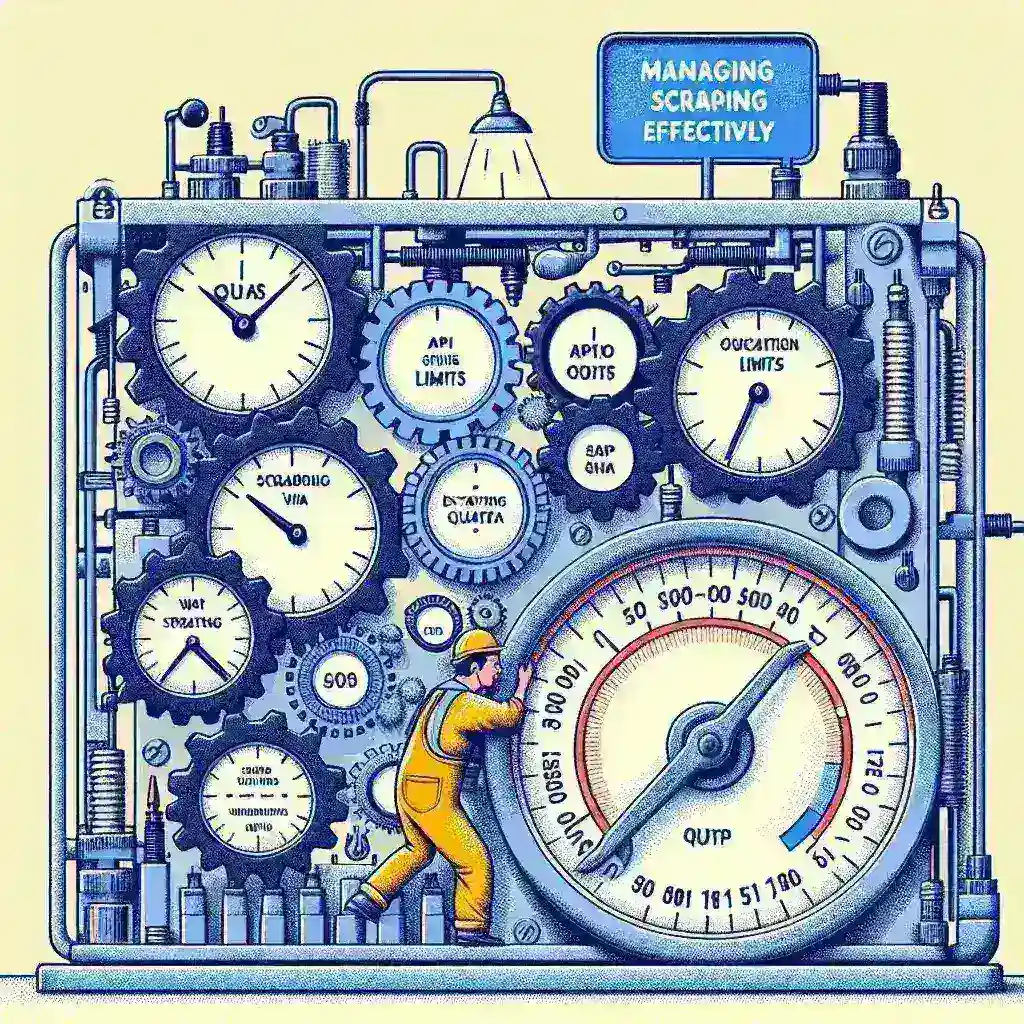Understanding API Limits and Quotas in Web Scraping
In the rapidly evolving digital landscape, web scraping has become an indispensable tool for businesses, researchers, and developers seeking to extract valuable data from online sources. However, as the practice has grown in popularity, so too have the protective measures implemented by website owners and API providers. API limits and quotas represent the frontline defense against excessive data extraction, creating a complex challenge that requires strategic navigation.
API limits, also known as rate limits, are restrictions placed on the number of requests a user can make to an API within a specific timeframe. These limitations serve multiple purposes: protecting server resources, ensuring fair usage among all users, and maintaining optimal performance for legitimate traffic. Understanding these constraints is crucial for anyone engaged in large-scale data collection activities.
The Evolution of Rate Limiting Technologies
The concept of rate limiting has evolved significantly since the early days of the internet. Initially, simple request-per-minute restrictions were sufficient to manage traffic. Today’s sophisticated systems employ dynamic throttling, user-based quotas, and intelligent detection algorithms that can identify and respond to scraping patterns in real-time.
Modern API providers implement tiered quota systems that differentiate between various user categories. Free-tier users might face stringent limitations of 100 requests per hour, while premium subscribers enjoy allowances of thousands of requests per minute. This stratification reflects the business model underlying many API services, where data access is monetized through subscription tiers.
Common Types of API Restrictions
Understanding the various forms of API limitations is essential for developing effective scraping strategies. The most prevalent restrictions include:
- Request Rate Limits: These impose restrictions on the number of requests permitted within specific time windows, such as 1000 requests per hour or 50 requests per minute.
- Daily/Monthly Quotas: These establish maximum usage thresholds over extended periods, often resetting at predetermined intervals.
- Concurrent Connection Limits: These restrict the number of simultaneous connections a single user can maintain with the API.
- Data Volume Restrictions: Some APIs limit the amount of data that can be retrieved in a single request or within a given timeframe.
- Geographic Limitations: Certain APIs implement location-based restrictions, limiting access from specific regions or countries.
The Psychology Behind Rate Limiting
From a behavioral perspective, rate limiting serves as both a technical necessity and a psychological deterrent. Website owners recognize that aggressive scraping can degrade user experience for legitimate visitors, potentially resulting in lost revenue and damaged reputation. By implementing reasonable restrictions, they create a framework that encourages responsible data consumption while deterring malicious actors.
Strategic Approaches to Volume Management
Effective scraping volume management requires a multifaceted approach that combines technical sophistication with strategic planning. The most successful practitioners employ a combination of techniques designed to maximize data collection while minimizing the risk of detection and blocking.
Request Spacing and Timing Optimization
One of the fundamental principles of responsible scraping involves implementing intelligent request spacing. Rather than bombarding servers with rapid-fire requests, sophisticated scrapers introduce variable delays between requests, mimicking human browsing patterns. This approach not only reduces the likelihood of triggering rate limits but also demonstrates respect for the target server’s resources.
Advanced timing strategies incorporate randomization elements, ensuring that request patterns don’t follow predictable sequences that might trigger automated detection systems. Some practitioners implement circadian rhythm modeling, adjusting scraping intensity based on the target website’s typical traffic patterns and server load cycles.
Distributed Scraping Architectures
Modern scraping operations increasingly rely on distributed architectures that spread requests across multiple IP addresses, user agents, and geographic locations. This approach offers several advantages: it reduces the load on any single endpoint, minimizes the risk of IP-based blocking, and allows for greater overall throughput while remaining within individual rate limits.
Cloud-based scraping solutions have revolutionized this approach, enabling practitioners to deploy scraping operations across multiple regions simultaneously. By leveraging services like AWS, Google Cloud, or Azure, scrapers can dynamically scale their operations based on demand while maintaining compliance with rate limiting restrictions.
Technical Implementation Strategies
The technical implementation of rate limit management requires careful consideration of both the scraping infrastructure and the target API’s specific limitations. Successful implementations typically incorporate multiple layers of protection and optimization.
Intelligent Queue Management
Advanced scraping systems implement sophisticated queue management algorithms that prioritize requests based on urgency, data value, and rate limit availability. These systems continuously monitor API response headers for rate limit information, dynamically adjusting request frequency to maximize throughput while avoiding violations.
Priority-based queuing allows scrapers to focus on high-value data during periods of limited API access, ensuring that critical information is collected even when operating under strict rate limits. This approach proves particularly valuable for time-sensitive applications such as price monitoring or news aggregation.
Adaptive Rate Control Mechanisms
Modern scraping frameworks incorporate adaptive rate control mechanisms that automatically adjust request frequency based on real-time feedback from target APIs. These systems monitor response times, error rates, and explicit rate limit headers to optimize performance dynamically.
When an API begins showing signs of stress—such as increased response times or occasional timeout errors—adaptive systems automatically reduce request frequency, allowing the server to recover while maintaining data collection continuity. This proactive approach helps prevent complete blocking while maximizing data acquisition efficiency.
Monitoring and Analytics for Rate Limit Optimization
Effective rate limit management relies heavily on comprehensive monitoring and analytics capabilities. Successful scraping operations implement detailed logging systems that track request patterns, response times, error rates, and rate limit consumption across all active endpoints.
Real-Time Dashboard Implementation
Professional scraping operations benefit significantly from real-time monitoring dashboards that provide instant visibility into rate limit status across all active APIs. These dashboards typically display current usage levels, remaining quotas, and projected depletion times, enabling operators to make informed decisions about resource allocation and request prioritization.
Advanced dashboard implementations incorporate predictive analytics capabilities, using historical usage patterns to forecast future rate limit consumption and identify potential bottlenecks before they impact operations. This proactive approach enables teams to adjust strategies preemptively rather than reactively responding to rate limit violations.
Historical Analysis and Pattern Recognition
Long-term success in rate limit management requires thorough analysis of historical data to identify patterns and optimize future operations. Successful practitioners maintain comprehensive databases of rate limit interactions, analyzing trends in API behavior, optimal request timing, and seasonal variations in rate limit enforcement.
This historical perspective enables the development of sophisticated predictive models that can anticipate rate limit changes, identify optimal scraping windows, and adjust strategies based on learned patterns. Machine learning algorithms can identify subtle correlations between request patterns and rate limit responses, enabling increasingly refined optimization strategies.
Compliance and Ethical Considerations
The landscape of web scraping operates within a complex framework of legal, ethical, and technical considerations. Responsible practitioners recognize that effective rate limit management extends beyond mere technical implementation to encompass broader principles of digital citizenship and respect for online resources.
Terms of Service Compliance
Every API and website operates under specific terms of service that define acceptable usage patterns and limitations. Responsible scrapers invest significant effort in understanding and complying with these terms, recognizing that technical capability to circumvent restrictions doesn’t necessarily grant legal or ethical permission to do so.
Regular review of terms of service updates ensures ongoing compliance as providers adjust their policies in response to changing usage patterns and business requirements. Many successful scraping operations establish formal compliance review processes, involving legal counsel when necessary to ensure continued adherence to evolving standards.
Industry Best Practices and Standards
The scraping community has developed numerous best practices and informal standards that promote responsible data collection. These guidelines emphasize respect for server resources, consideration for other users, and recognition of the legitimate business interests of data providers.
Professional scraping operations often exceed minimum compliance requirements, implementing voluntary restrictions that demonstrate good faith engagement with data providers. This approach can lead to more favorable treatment from API providers and reduce the likelihood of aggressive rate limiting or blocking measures.
Future Trends in Rate Limiting and Scraping
The ongoing evolution of both scraping technologies and rate limiting mechanisms promises continued innovation in this space. Emerging trends suggest increasingly sophisticated approaches to both data collection and protection, requiring practitioners to remain adaptable and forward-thinking in their strategies.
Artificial Intelligence and Machine Learning Integration
The integration of artificial intelligence and machine learning technologies is transforming both sides of the rate limiting equation. Scraping operations increasingly employ AI-driven optimization algorithms that can adapt to changing rate limit patterns in real-time, while API providers implement intelligent detection systems capable of identifying and responding to sophisticated scraping attempts.
These technological advances promise more nuanced and effective rate limiting mechanisms that can distinguish between legitimate research activities and aggressive commercial scraping, potentially leading to more favorable treatment for responsible practitioners while maintaining protection against abusive usage patterns.
Collaborative Frameworks and Data Sharing Agreements
An emerging trend involves the development of collaborative frameworks that formalize data sharing relationships between scrapers and data providers. These agreements establish clear guidelines for data access, usage limitations, and rate limit parameters, creating mutually beneficial arrangements that serve the interests of both parties.
Such frameworks represent a maturation of the scraping ecosystem, moving beyond adversarial relationships toward cooperative models that recognize the legitimate value of data aggregation and analysis while respecting the rights and interests of data providers.
Conclusion
The effective management of API limits and quotas in web scraping represents a critical competency for anyone engaged in large-scale data collection activities. Success in this domain requires a comprehensive understanding of technical implementation strategies, ethical considerations, and evolving industry standards.
As the digital landscape continues to evolve, the most successful practitioners will be those who combine technical sophistication with ethical responsibility, developing scraping operations that respect rate limits while maximizing data collection efficiency. The future of web scraping lies not in circumventing restrictions, but in working within established frameworks to create value for all stakeholders in the data ecosystem.
By implementing the strategies and best practices outlined in this guide, organizations can develop robust, compliant, and efficient scraping operations that deliver valuable insights while maintaining positive relationships with data providers. The key lies in viewing rate limits not as obstacles to overcome, but as guidelines that enable sustainable and responsible data collection practices.



